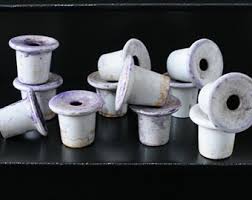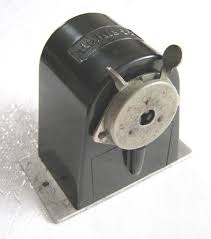When I started school there were pencils which we learned to write with and pens which we were allowed to write with when we were a bit older, maybe seven or eight. Not much has changed. Except for the pens and, to a lesser extent, the pencils.
The only pens provided in my Primary School were the wooden handled dipping pens.



The ink for the pens was held in little china inkwells which fitted into holes in the desks. Each morning the ink monitors would make up a big jug of ink using ink powder and water, fill a trayful of inkwells, then place an inkwell into each desk hole. The standard issue school ink was a shade called blue-black. I hated the dullness of that colour and longed to write with a bright blue ink. Although the top year in our primary school (eleven year olds) were allowed to use their own pens, the headteacher loathed ball-points (biros) calling them ‘new-fangled rubbish’ and banned us from using them. If you were lucky enough to have your own fountain pen, and I got one for my eleventh birthday which saw me all the way through high school, you could use that in school. I would fill mine from a bottle of Quink at home so that I didn’t have to use school blue-black ink. Parker pens were the most desirable but most of us had the more affordable Platignum pens. There were no other types of pen apart from Dipping pens, fountain pens and biros. Fibre tips, toller ball, fine felt-tips, fibre tips all had yet to be invented or at least to become mainstream. I remember when Tempo pens arrived on the scene when I was a student (and still a fountain pen user) and I loved them! To this day I am still not a fan of writing in biro, preferring ink pens or pencil.


There isn’t as much to say about pencils. There is a vast array of colours and styles available now but the fundamental design hasn’t changed. I do remember we children being very excited in school when the teacher acquired a desk mounted pencil sharpener. What a joy to use! We all wanted to be pencil monitor and have the job of sharpening the class’ pencils first thing in the morning. These gadgets still exist, I have seen them in some classrooms in schools I worked in. The design hasn’t changed.



Then we come to colouring pencils or ‘crayons’. Again, the basic design remains unchanged. One well known brand I remember well is Lakeland. I loved the tins they came in with a Lakeland scene on the lid. Even the smallest tins of their crayons had the scenic image on the tin.


I didn’t know then but the reason they were called Lakeland was because they were manufactured in the Lake District. The Derwent pencil company began in 1832 in Keswick, Cumbria and remained well known for producing the finest pencils in the world. There is even a pencil museum in Keswick.
 Keswick’s Pencil Museum.
Keswick’s Pencil Museum.
As always, images are courtesy of Google Images and Wikipedia. If anyone objects to my use of any picture please contact me so that I can remove it.